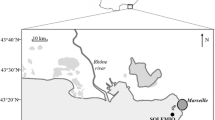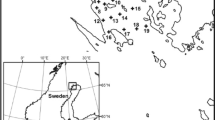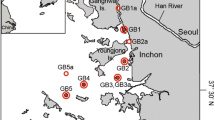Abstract
Data from several years of monthly samplings are combined with a 1-year detailed study of carbon flux through bacteria at a NW Mediterranean coastal site to delineate the bacterial role in carbon use and to assess whether environmental factors or bacterial assemblage composition affected the in situ rates of bacterial carbon processing. Leucine (Leu) uptake rates [as an estimate of bacterial heterotrophic production (BHP)] showed high interannual variability but, on average, lower values were found in winter (around 50 pM Leu−1 h−1) as compared to summer (around 150 pM Leu−1 h−1). Leu-to-carbon conversion factors ranged from 0.9 to 3.6 kgC mol Leu−1, with generally higher values in winter. Leu uptake was only weakly correlated to temperature, and over a full-year cycle (in 2003), Leu uptake peaked concomitantly with winter chlorophyll a (Chl a) maxima, and in periods of high ectoenzyme activities in spring and summer. This suggests that both low molecular weight dissolved organic matter (DOM) released by phytoplankton, and high molecular weight DOM in periods of low Chl a, can enhance BHP. Bacterial respiration (BR, range 7–48 μg C l−1 d−1) was not correlated to BHP or temperature, but was significantly correlated to DOC concentration. Total bacterial carbon demand (BHP plus BR) was only met by dissolved organic carbon produced by phytoplankton during the winter period. We measured bacterial growth efficiencies by the short-term and the long-term methods and they ranged from 3 to 42%, increasing during the phytoplankton blooms in winter (during the Chl a peaks), and in spring. Changes in bacterioplankton assemblage structure (as depicted by denaturing gradient gel electrophoresis fingerprinting) were not coupled to changes in ecosystem functioning, at least in bacterial carbon use.






Similar content being viewed by others
References
Agustí S, Satta MP, Mura MP, Benavent E. 1998. Dissolved esterase activity as a tracer of phytoplankton lysis: evidence of high phytoplankton lysis rates in the northwestern Mediterranean. Limnol Oceanogr 43:1836–49..
Alonso-Sáez L, Gasol JM. 2007. Seasonal variations in the contributions of different bacterial groups to the uptake of low-molecular-weight compounds in Northwestern Mediterranean coastal waters. Appl Environ Microbiol 73:3528–35.
Alonso-Sáez L, Arístegui J, Pinhassi J, Gómez-Consarnau L, González JM, Vaqué D, Agustí S, Gasol JM. 2007a. Bacterial assemblage structure and carbon metabolism along a productivity gradient in the NE Atlantic Ocean. Aquat Microb Ecol 46:43–53.
Alonso-Sáez L, Balagué V, Sà E, Sánchez O, González JM, Pinhassi J, Massana R, Pernthaler J, Pedrós Alió C, Gasol JM. 2007b. Seasonality in bacterial diversity in NW Mediterranean coastal waters: assessment through clone libraries, fingerprinting and fluorescence in situ hybridization. FEMS Microb Ecol 60:98–112.
Alonso-Sáez L, Gasol JM, Arístegui J, Vilas JC, Vaqué D, Duarte CM, Agustí S. 2007c. Large scale variability in surface bacterial carbon demand and growth efficiency in the subtropical North East Atlantic Ocean. Limnol Oceanogr 52:533–46.
Apple JK, del Giorgio PA, Kemp WM. 2006. Temperature regulation of bacterial production, respiration, and growth efficiency in a temperate salt-marsh estuary. Aquat Microb Ecol 43:243–354.
Bjørnsen PK, Kuparinen J. 1991. Determination of bacterioplankton biomass, net production and growth efficiency in the Southern Ocean. Mar Ecol Prog Ser 71:185–94.
Briand E, Pringault O, Jacquet S, Torréton JP. 2004. The use of oxygen microprobes to measure bacterial respiration for determining bacterioplankton growth efficiency. Limnol Oceanogr:Methods 2:406–16.
Carlson CA, Ducklow HW. 1996. Growth of bacterioplankton and consumption of dissolved organic carbon in the Sargasso Sea. Aquat Microb Ecol 10:69–85.
Christian JR, Karl DM. 1995. Bacterial ectoenzymes in marine waters: activity ratios and temperature responses in three oceanographic provinces. Limnol Oceanogr 40:1042–9.
Chróst RJ. 1992. Significance of bacterial ectoenzymes in aquatic environments. Hydrobiologia 243–244:61–70.
Cole JJ, Findlay S, Pace ML. 1988. Bacterial production in fresh and saltwater ecosystems: a cross-system overview. Mar Ecol Prog Ser 43:1–10.
Cottrell MT, Kirchman DL. 2000. Natural assemblages of marine proteobacteria and members of the cytophaga-flavobacter cluster consuming low- and high-molecular-weight dissolved organic matter. Appl Environ Microbiol 66:1692–7. QUITAR?
del Giorgio PA, Cole JJ. 1998. Bacterial growth efficiency in natural aquatic systems. Annu Rev Ecol Syst 29:503–41.
del Giorgio PA, Cole JJ. 2000. Bacterial energetics and growth efficiency. In: Kirchman DL, Ed. Microbial ecology of the oceans. New York: Wiley-Liss. pp 289–325.
Duarte CM, Agustí S, Kennedy H, Vaqué D. 1999. The Mediterranean climate as a template for mediterranean marine ecosystems: the example of the northeast Spanish littoral. Progr Oceanogr 44:245–70.
Ducklow HW, Carlson CA. 1992. Oceanic bacterial production. Adv Microb Ecol 12:113–81.
Fernandez M, Bianchi M, Van Wambeke F. 1994. Bacterial biomass, heterotrophic production and utilization of dissolved organic matter photosynthetically produced in the Almeria-Oran front. J Mar Syst 5:313–25.
Fuhrman JA, Hewson I, Schwalback MS, Steele JA, Brown MV, Naeem S. 2006. Annually reoccurring bacterial communities are predictable from ocean conditions. Proc Nat Acad Sci 103:13104–9.
Gasol JM, del Giorgio PA. 2000. Using flow cytometry for counting natural planktonic bacteria and understanding the structure of planktonic bacterial communities. Sci Mar 64:197–224.
Gasol JM, Duarte CM. 2000. Comparative analyses in aquatic microbial ecology: how far do they go? FEMS Microbiol Ecol 31:99–106.
Goldman JC, Caron DA, Dennett MR. 1987. Regulation of gross growth efficiency and ammonium regeneration in bacteria by substrate C:N ratio. Limnol Oceanogr 32:1239–52.
González N, Anadón R, Viesca L. 2003. Carbon flux through the microbial community in a temperate sea during summer: role of bacterial metabolism. Aquat Microb Ecol 33:117–26.
Grasshoff K, Ehrhardt M, Kremling K. 1983. Methods on seawater analysis, 2nd Edn. Weinheim: Verlag Chemie.
Hoppe HG. 1983. Significance of exoenzymatic activities in the ecology of brackish water: measurements by means of methylumbelliferyl-substrates. Mar Ecol Prog Ser 11:299–308.
Jahnke RA, Craven DB. 1995. Quantifying the role of heterotrophic bacteria in the carbon cycle: a need for respiration rate measurements. Limnol Oceanogr 40:436–41.
Kirchman DL, K’nees E Hodson R. 1985. Leucine incorporation and its potential as a measure of protein synthesis by bacteria in natural aquatic ecosystems. Appl Env Microbiol 49:599–607.
Kroer N. 1993. Bacterial growth efficiency on natural dissolved organic matter. Limnol Oceanogr 38:1282–90.
Krom MD, Brenner S, Kress N, Neori A, Gordon LI. 1993. Nutrient distributions during an annual cycle across a warm-core eddy from the E Mediterranean Sea. Deep-Sea Res I 40:805–25.
Lemée R, Rochelle-Newall E, Van Wambeke F, Pizay M-D, Rinaldi P, Gattuso J-P. 2002. Seasonal variation of bacterial production respiration and growth efficiency in the open NW Mediterranean Sea. Aquat Microb Ecol 29:227–37.
Lucea A, Duarte CM, Agustí S, Kennedy H. 2005. Nutrient dynamics and ecosystem metabolism in the Bay of Blanes (NW Mediterranean).Biogeochemistry 73:303–23.
Misic C, Povero P, Fabiano M. 2002. Ectoenzymatic ratios in relation to particulate organic matter distributions (Ross Sea, Antarctica). Microb Ecol 44:224–34.
Morán XAG, Estrada M. 2001. Short-term variability of photsynthetically parameters and particulate and dissolved primary production in the Alboran Sea (SW Mediterranean). Mar Ecol Prog Ser 212:53–67.
Morán XAG, Estrada M. 2002. Phytoplanktonic DOC and POC production in the Bransfield and Gerlache straits as derived from kinetic experiments of 14C incorporation. Deep-Sea Res II 49:769–86.
Murrell MC. 2003. Bacterioplankton dynamics in a subtropical estuary: evidence for substrate limitation. Aquat Microb Ecol 32:239–50.
Nagata T. 2000. Production and mechanisms of dissolved organic matter. In: Kirchman DL, Ed. Microbial ecology of the oceans. New York: Wiley-Liss.
Norland S. 1993. The relationship between biomass and volume of bacteria. In: Kemp P, Sherr BF, Sherr E, Cole JJ, Eds. Handbook of methods in aquatic microbial ecology. Boca Raton: Lewis Publishing. pp 303–7.
Obernosterer I, Herndl G. 1995. Phytoplankton extracellular release and bacterial growth dependence on the inorganic N-P ratio. Mar Ecol Prog Ser 115:247–57.
Outdot CR, Gerard R, Morin P, Gningue I. 1988. Precise shipboard determination of dissolved oxygen (Winkler procedure) for productivity studies with a commercial system. Limnol Oceanogr 33:146–50.
Pinhassi J, Gómez-Consarnau L, Alonso-Sáez L, Sala MM, Vidal M, Pedrós-Alió C, Gasol JM. 2006. Seasonal changes in bacterioplankton nutrient limitation and their effects on bacterial community composition in the NW Mediterranean Sea. Aquat Microb Ecol 44:241–52.
Puddu A, Zoppinni A, Fazi S, Rosati M, Amalfitano S, Magaletti E. 2003. Bacterial uptake of DOM released from P-limited bacterioplankton. FEMS Microb Ecol 46:257–68.
Reinthaler T, Herndl GJ. 2005. Seasonal dynamics of bacterial growth efficiencies in relation to phytoplankton in the Southern North Sea. Aquat Microb Ecol 39:7–16.
Riemann B, Bjornsen PK, Newell S, Fallon R. 1987. Calculation of cell production of coastal marine bacteria based on measured incorporation of [3H] thymidine. Limnol Oceanogr 32:471–6.
Rivkin RB, Legendre L. 2001. Biogenic carbon cycling in the upper ocean: effects of microbial respiration. Science 291:2398–400.
Robinson C. Heterotrophic bacterial respiration. In: Kirchman, DL, Ed. Microbial ecology of the Ocean, 2nd Edn. (in press).
Robinson C, Williams PJB. 2005. Respiration and its measurement in surface marine waters, In: del Giorgio PA, Williams PJ, Eds. Respiration in aquatic ecosystems. Oxford University Press Inc, pp 147–80.
Sala MM, Karner M, Arin L, Marrasé C. 2001. Measurement of ectoenzyme activities as an indicator of inorganic nutrient imbalance in microbial communities. Aquat Microb Ecol 23: 301–11.
Satta MP, Agustí S, Mura MP, Vaqué D, Duarte CM. 1996. Microplankton respiration and net community metabolism in a bay on the NW Mediterranean coast. Aquat Microb Ecol 10:165–72.
Schauer M, Balagué V, Pedrós-Alió C, Massana R. 2003. Seasonal changes in the taxonomic composition of bacterioplankton in a coastal oligotrophic system. Aquat Microb Ecol 31:163–74.
Sherr EB, Sherr BF. 1996. Temporal offset in oceanic production and respiration processed implied by seasonal changes in atmospheric oxygen: the role of heterotrophic microbes. Aquat Microb Ecol 11:91–100.
Sherry ND, Boyd PW, Sugimoto K, Harrison PJ. 1999. Seasonal and spatial patterns of heterotrophic bacterial production, respiraton and biomass in the subarctic NE Pacific. Deep-Sea Res II 46: 2557–78.
Shiah F, Ducklow HW. 1994. Temperature regulation of heterotrophic bacterioplankton abundance, production, and specific growth rate in Chesapeake Bay. Limnol Oceanogr 39:1243–58.
Smith DC, Azam F. 1992. A simple, economical method for measuring bacterial protein synthesis rates in seawater using 3H-leucine. Mar Microb Food Webs 6:107–14.
Smith EM, Kemp WM. 1995. Seasonal and regional variations in plankton community production and respiration for Chesapeake Bay. Mar Ecol Prog Ser 116:217–31.
Smith EM, Prairie YT. 2004. Bacterial metabolism and growth efficiency in lakes: the importance of phosphorous availability. Limnol Oceanogr 49:137–47.
Staroscik AM, Smith DC. 2004. Seasonal patterns in bacterioplankton abundance and production in Narragansett Bay, Rhode Island, USA. Aquat Microb Ecol 35:275–82.
Straskraba M, Gnauck AH. 1985. Freshwater ecosystems: modellling and similation. Amsterdam: Elsevier. pp 309.
Teira E, Pazó MJ, Serret P, Fernández E. 2001. Dissolved organic carbon production by microbial populations in the Atlantic Ocean. Limnol Oceanogr 46:1370–7.
Thingstad TF, Hagström Å, Rassoulzadegan F. 1997. Accumulation of degradable DOC in surface waters: is it caused by a malfunctioning microbial loop? Limnol Oceanogr 42:398–404.
Urbani R, Magaletti E, Sist P, Cicero AM. 2005. Extracellular carbohydrates released by the marine diatoms Cylindrotheca closterium, Thalassiosira pseudonana and Skeletonema costatum: effect of P-depletion and growth status. Sci Total Environ 353:300–6.
White PA, Kalff J, Rasmussen JB, Gasol JM. 1991. The effect of temperature and algal biomass on bacterial production and specific growth rate in freshwater and marine habitats. Microb Ecol 21:99–118.
Williams PJ, del Giorgio PA. 2005. Respiration in aquatic ecosystems: history and background, In: del Giorgio PA, Williams PJ, Eds. Respiration in aquatic ecosystems. Oxford University Press Inc. pp 1–17.
Acknowledgments
This work was supported by the Spanish projects MicroDiff (REN2001-2110/MAR), ESTRAMAR (CTM2004-12631/MAR), GENμMAR (CTM2004-02586/MAR) and MODIVUS (CTM2005-04975/MAR), EU project BASICS (EVK3-CT-2002-00078), and NoE MARBEF. Financial support was provided by a PhD fellowship from the Spanish government to L.A.S. We thank X.A.G. Morán and M. Estrada for their help with the primary production measurements, J. Felipe for technical support with flow cytometry, I. Forn for her help with field sampling, C. Pedrós-Alió for general support and encouragement, and to two anonymous reviewers for helpful comments.
Author information
Authors and Affiliations
Corresponding author
Rights and permissions
About this article
Cite this article
Alonso-Sáez, L., Vázquez-Domínguez, E., Cardelús, C. et al. Factors Controlling the Year-Round Variability in Carbon Flux Through Bacteria in a Coastal Marine System. Ecosystems 11, 397–409 (2008). https://doi.org/10.1007/s10021-008-9129-0
Received:
Revised:
Accepted:
Published:
Issue Date:
DOI: https://doi.org/10.1007/s10021-008-9129-0




